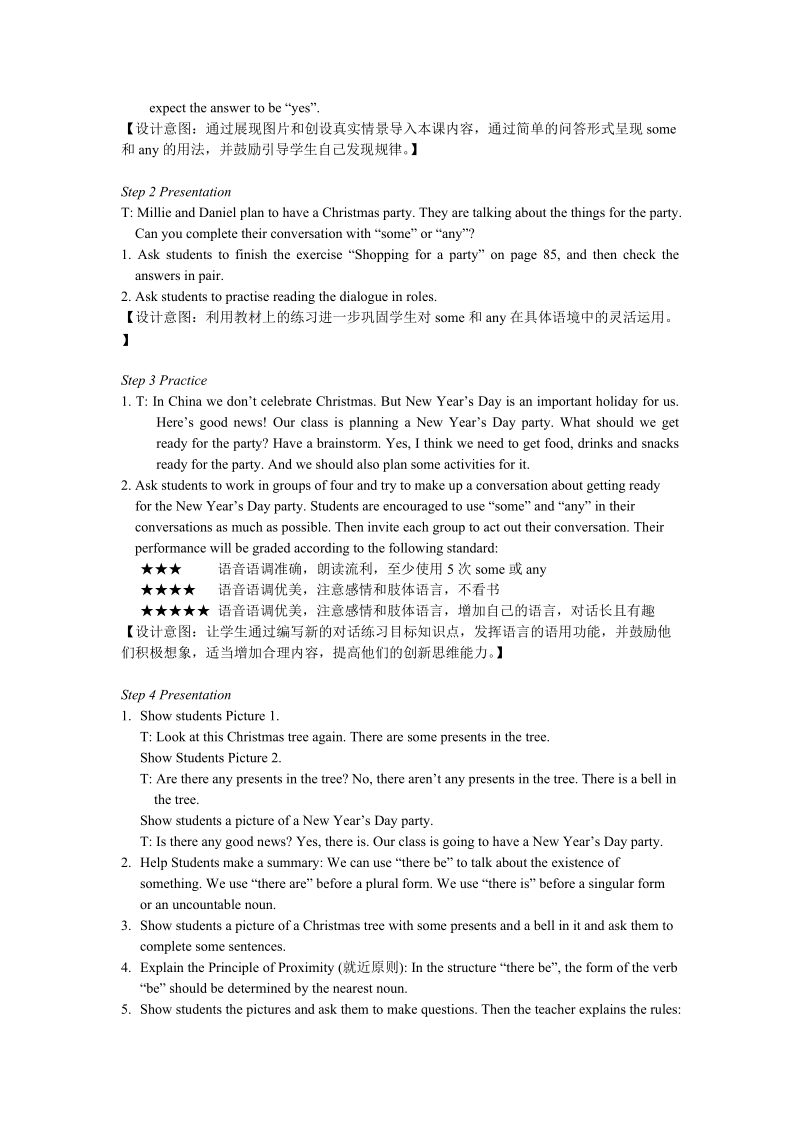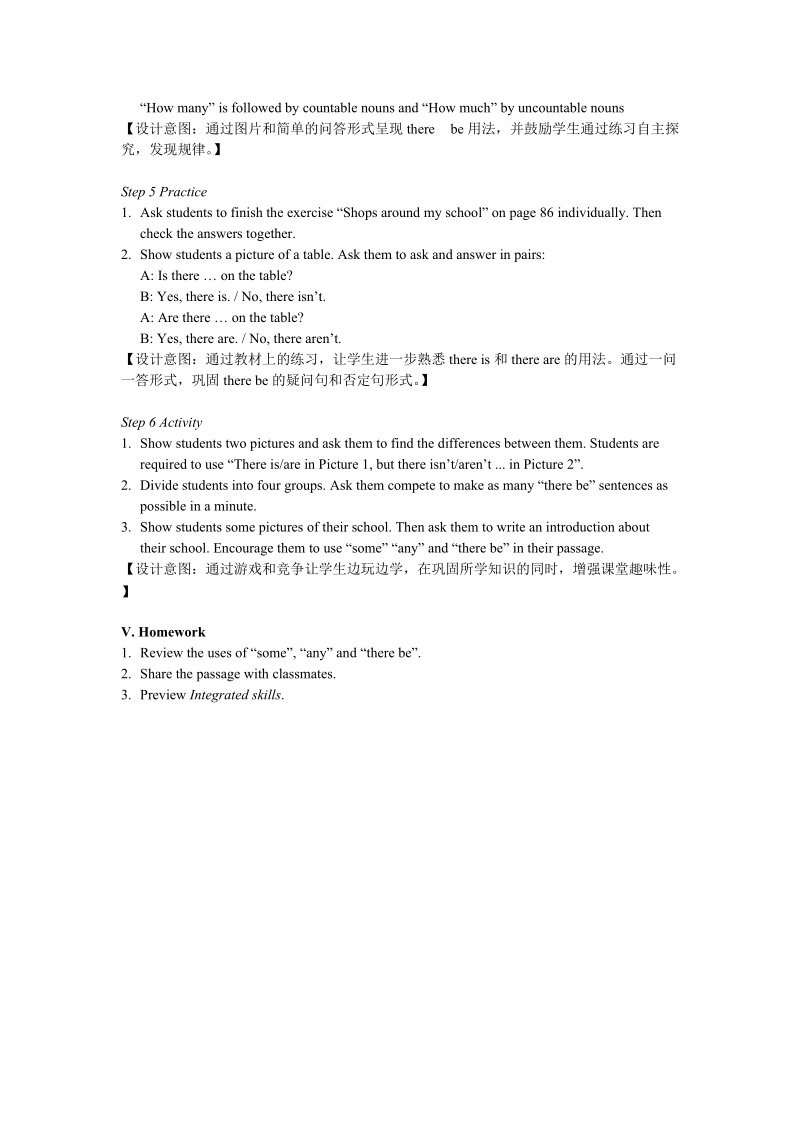 牛津译林版七年级上英语Unit7 Grammar 教案
牛津译林版七年级上英语Unit7 Grammar 教案
《牛津译林版七年级上英语Unit7 Grammar 教案》由会员分享,可在线阅读,更多相关《牛津译林版七年级上英语Unit7 Grammar 教案(3页珍藏版)》请在七七文库上搜索。
1、Unit 7 Shopping GrammarI. Teaching aims and learning objectivesBy the end of the lesson, students should be able to:1. use “some” and “any” to talk about the amount of something;2. use “there be” to show the idea that something exists;3. develop the cognitive ability to discover rules. II. Teaching
2、contents1. New words and phrases: paper2. New structures: I need to buy some Christmas presentsDo you have any money?I dont have any money.There is a pear on the table.There is some milk on the table.There is not any bread on the table.There are not any cakes on the table.Is there a pear on the tabl
3、e?Is there any salt on the table?Yes, there is. / No, there isnt.Are there any vegetables on the table?Yes, there is. / No, there isnt.III. Focus of the lesson and predicted area of difficultyUse “some”, “any” and “there be” to write an introduction about the students school.IV. Teaching proceduresS
4、tep 1 Lead-in1. Show students Picture 1.T: Hello, everyone! As we know, Christmas is coming soon. I have a Christmas tree here. Tell me, what can you see in the tree? Yes, we can see some presents in it.Show students Picture 2.T: What about this one? Can you see any presents in the tree? No, we cant
5、 see any presents in it. T: I want to buy some Christmas presents. So I need some money. Do you have any money?S1: No, I dont have any money.Ask another student: What about you? Would you like some Christmas presents? Can I borrow some money from you?2. Ask students to think carefully and work out t
6、he rules about how to use “some” and “any”.T: We can use “some” and “any” before both countable nouns and uncountable nouns. We use “some” in a positive sentence. We use “any” in a negative sentence and a question. We can also use “some” in a question when we are making an offer or a request. We use
7、 it when we expect the answer to be “yes”.【设计意图:通过展现图片和创设真实情景导入本课内容,通过简单的问答形式呈现 some和 any 的用法,并鼓励引导学生自己发现规律。 】Step 2 PresentationT: Millie and Daniel plan to have a Christmas party. They are talking about the things for the party. Can you complete their conversation with “some” or “any”?1. Ask stude
8、nts to finish the exercise “Shopping for a party” on page 85, and then check the answers in pair.2. Ask students to practise reading the dialogue in roles.【设计意图:利用教材上的练习进一步巩固学生对 some 和 any 在具体语境中的灵活运用。】Step 3 Practice 1. T: In China we dont celebrate Christmas. But New Years Day is an important holi



- 配套讲稿:
如PPT文件的首页显示word图标,表示该PPT已包含配套word讲稿。双击word图标可打开word文档。
- 特殊限制:
部分文档作品中含有的国旗、国徽等图片,仅作为作品整体效果示例展示,禁止商用。设计者仅对作品中独创性部分享有著作权。
- 关 键 词:
- 牛津 译林版七 年级 英语 Unit7Grammar 教案
 七七文库所有资源均是用户自行上传分享,仅供网友学习交流,未经上传用户书面授权,请勿作他用。
七七文库所有资源均是用户自行上传分享,仅供网友学习交流,未经上传用户书面授权,请勿作他用。
文档标签
- 译林版七
- 牛津译林版七年级上英语Unit2 Grammar 教案
- 牛津译林版七年级英语上Unit7检测题含详解
- 牛津译林版七年级上英语Unit7 Task 教案
- 牛津译林版八年级上英语Unit7 Grammar 教案
- 牛津译林版七年级英语上Unit7 Reading2课件
- 牛津译林版七年级上Unit7 Grammar课件
- 牛津译林版五年级下英语Unit7 Grammar time
- 牛津译林版七年级上英语Unit7 Reading II 教案
- 牛津译林版七年级下英语Unit7 Grammar 教案
- 牛津译林版七年级下英语Unit7 Task 教案
- 牛津译林版七年级上英语Unit7 Grammar 教案
- 牛津译林版七年级上英语Unit4 Grammar 教案
- 牛津译林版七年级上英语Unit7 Reading I 教案
- 牛津译林版七年级英语上Unit7 Reading1课件
- 牛津译林版七年级上英语Unit1 Grammar 教案
- 牛津译林版七年级上英语Unit3 Grammar 教案
- 牛津译林版三年级上英语Unit7 教案
- 七年级下unit7教案译林



 浙公网安备33030202001339号
浙公网安备33030202001339号
链接地址:https://www.77wenku.com/p-86947.html